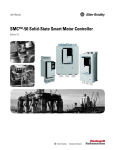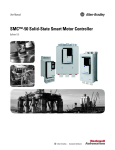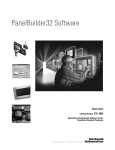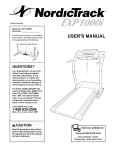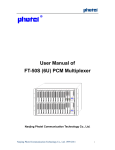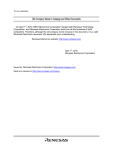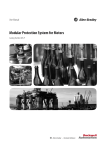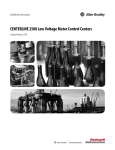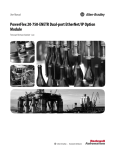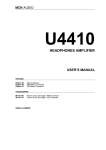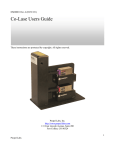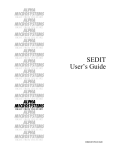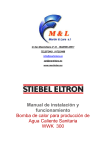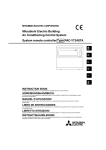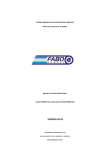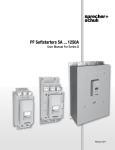Download SMC-50 Quick Start Manual
Transcript
Quick Start SMC™-50 Solid-State Smart Motor Controller Bulletin 150 Important User Information Read this document and the documents listed in the additional resources section about installation, configuration, and operation of this equipment before you install, configure, operate, or maintain this product. Users are required to familiarize themselves with installation and wiring instructions in addition to requirements of all applicable codes, laws, and standards. Activities including installation, adjustments, putting into service, use, assembly, disassembly, and maintenance are required to be carried out by suitably trained personnel in accordance with applicable code of practice. If this equipment is used in a manner not specified by the manufacturer, the protection provided by the equipment may be impaired. In no event will Rockwell Automation, Inc. be responsible or liable for indirect or consequential damages resulting from the use or application of this equipment. The examples and diagrams in this manual are included solely for illustrative purposes. Because of the many variables and requirements associated with any particular installation, Rockwell Automation, Inc. cannot assume responsibility or liability for actual use based on the examples and diagrams. No patent liability is assumed by Rockwell Automation, Inc. with respect to use of information, circuits, equipment, or software described in this manual. Reproduction of the contents of this manual, in whole or in part, without written permission of Rockwell Automation, Inc., is prohibited. Throughout this manual, when necessary, we use notes to make you aware of safety considerations. WARNING: Identifies information about practices or circumstances that can cause an explosion in a hazardous environment, which may lead to personal injury or death, property damage, or economic loss. ATTENTION: Identifies information about practices or circumstances that can lead to personal injury or death, property damage, or economic loss. Attentions help you identify a hazard, avoid a hazard, and recognize the consequence. IMPORTANT Identifies information that is critical for successful application and understanding of the product. Labels may also be on or inside the equipment to provide specific precautions. SHOCK HAZARD: Labels may be on or inside the equipment, for example, a drive or motor, to alert people that dangerous voltage may be present. BURN HAZARD: Labels may be on or inside the equipment, for example, a drive or motor, to alert people that surfaces may reach dangerous temperatures. ARC FLASH HAZARD: Labels may be on or inside the equipment, for example, a motor control center, to alert people to potential Arc Flash. Arc Flash will cause severe injury or death. Wear proper Personal Protective Equipment (PPE). Follow ALL Regulatory requirements for safe work practices and for Personal Protective Equipment (PPE). Allen-Bradley, Rockwell Software, Rockwell Automation, and TechConnect are trademarks of Rockwell Automation, Inc. Trademarks not belonging to Rockwell Automation are property of their respective companies. Table of Contents Chapter 1 Introduction SMC-50. . . . . . . . . . . . . . . . . . . . . . . . . . . . . . . . . . . . . . . . . . . . . . . . . . . . . . . . . . . 3 General Precautions . . . . . . . . . . . . . . . . . . . . . . . . . . . . . . . . . . . . . . . . . . . . . . . . 4 Chapter 2 Installation Mounting Requirements. . . . . . . . . . . . . . . . . . . . . . . . . . . . . . . . . . . . . . . . . . . . 7 Dimensions. . . . . . . . . . . . . . . . . . . . . . . . . . . . . . . . . . . . . . . . . . . . . . . . . . . . . . . . 8 Cat. No. 150-SB… Controllers. . . . . . . . . . . . . . . . . . . . . . . . . . . . . . . . . . . 8 Cat. No. 150-SC… Controllers . . . . . . . . . . . . . . . . . . . . . . . . . . . . . . . . 10 Cat. No. 150-SD… Controllers . . . . . . . . . . . . . . . . . . . . . . . . . . . . . . . . 12 Power Wiring. . . . . . . . . . . . . . . . . . . . . . . . . . . . . . . . . . . . . . . . . . . . . . . . . . . . 13 Use of Power Factor Connection Capacitors (PFCCs) . . . . . . . . . . 15 Typical Power Diagrams . . . . . . . . . . . . . . . . . . . . . . . . . . . . . . . . . . . . . . 15 Control Wiring . . . . . . . . . . . . . . . . . . . . . . . . . . . . . . . . . . . . . . . . . . . . . . . . . . 16 Standard Control Terminal Block . . . . . . . . . . . . . . . . . . . . . . . . . . . . . 16 Control Wiring Specifications . . . . . . . . . . . . . . . . . . . . . . . . . . . . . . . . . 16 Typical Control Wiring Examples . . . . . . . . . . . . . . . . . . . . . . . . . . . . . 18 Option Modules . . . . . . . . . . . . . . . . . . . . . . . . . . . . . . . . . . . . . . . . . . . . . . . . . 19 Optional Cat. No. 150-SM4 Digital I/O Module . . . . . . . . . . . . . . . 20 Optional Cat. No. 150-SM3 Analog I/O Module . . . . . . . . . . . . . . . 21 Optional Cat. No. 150-SM6 Parameter Configuration Module (PCM) . . . . . . . . . . . . . . . . . . . . . . . . . . . . . . . . . . . . . . . . . . . . . . . . . . . . . . 23 Additional Options . . . . . . . . . . . . . . . . . . . . . . . . . . . . . . . . . . . . . . . . . . . . . . 24 Optional Cat. No. 150-SM2 Positive Temperature Coefficient (PTC), Ground-Fault, & External Current Transformer Option Module . . . . . . . . . . . . . . . . . . . . . . . . . . . . . . . . . . . . . . . . . . . . . . . . . . . . . . 24 Current Feedback Sensor (825-MCM Converter Module). . . . . . . 24 Ground Fault Feedback Sensor . . . . . . . . . . . . . . . . . . . . . . . . . . . . . . . . 25 PTC Thermistor Sensors. . . . . . . . . . . . . . . . . . . . . . . . . . . . . . . . . . . . . . 26 Bypass Diagrams . . . . . . . . . . . . . . . . . . . . . . . . . . . . . . . . . . . . . . . . . . . . . . . . . 27 Converter Modules . . . . . . . . . . . . . . . . . . . . . . . . . . . . . . . . . . . . . . . . . . . 27 Chapter 3 Programming Parameter Configuration/Programming . . . . . . . . . . . . . . . . . . . . . . . . . . . Parameter Configuration using the Cat. No. 150-SM6 Parameter Configuration Module (PCM) . . . . . . . . . . . . . . . . . . . . . . . . . . . . . . . . Parameter Configuration using a 20-HIM-A6 (FRN1.006 or later) . . . . . . . . . . . . . . . . . . . . . . . . . . . . . . . . . . . . . . . . . . Basic Parameter Access & Category/File Structure . . . . . . . . . . . . . . . . . . Parameter Access . . . . . . . . . . . . . . . . . . . . . . . . . . . . . . . . . . . . . . . . . . . . . Category/File Structure . . . . . . . . . . . . . . . . . . . . . . . . . . . . . . . . . . . . . . . Quick Setup . . . . . . . . . . . . . . . . . . . . . . . . . . . . . . . . . . . . . . . . . . . . . . . . . Rockwell Automation Publication 150-QS003D-EN-P - November 2013 33 33 39 41 41 44 46 1 Table of Contents Chapter 4 Operation and Troubleshooting Operation . . . . . . . . . . . . . . . . . . . . . . . . . . . . . . . . . . . . . . . . . . . . . . . . . . . . . . . 47 Motor Configuration . . . . . . . . . . . . . . . . . . . . . . . . . . . . . . . . . . . . . . . . . . . . . 47 Motor Tuning . . . . . . . . . . . . . . . . . . . . . . . . . . . . . . . . . . . . . . . . . . . . . . . . . . . 47 Troubleshooting with Diagnostic LEDs . . . . . . . . . . . . . . . . . . . . . . . . . . . . 48 Controller LED Status Indicator. . . . . . . . . . . . . . . . . . . . . . . . . . . . . . . 48 Using the Controller Status LED & Parameter Configuration Module (Cat. No. 150-SM6) LEDs . . . . . . . . . . . . . . . . . . . . . . . . . . . . . . . . . . . . 49 Troubleshooting with Monitoring Equipment . . . . . . . . . . . . . . . . . . . . . . 50 Troubleshooting By Fault Code — Abbreviated Listing . . . . . . . . . . . . . 50 Appendix A SCCR Ratings SCCR Ratings . . . . . . . . . . . . . . . . . . . . . . . . . . . . . . . . . . . . . . . . . . . . . . . . . . . 53 Appendix B Repair/Replacement Parts 2 Control Module. . . . . . . . . . . . . . . . . . . . . . . . . . . . . . . . . . . . . . . . . . . . . . . . . . Power Poles . . . . . . . . . . . . . . . . . . . . . . . . . . . . . . . . . . . . . . . . . . . . . . . . . . . . . . Heatsink Fans. . . . . . . . . . . . . . . . . . . . . . . . . . . . . . . . . . . . . . . . . . . . . . . . . . . . Other Components. . . . . . . . . . . . . . . . . . . . . . . . . . . . . . . . . . . . . . . . . . . . . . . Rockwell Automation Publication 150-QS003D-EN-P - November 2013 55 55 55 56 Chapter 1 Introduction SMC-50 This Quick Start guide provides you with the basic information required to install, start up, and program your SMC™-50 Soft Starter. The SMC-50 is a reduced voltage soft starter that utilizes a state-of-the-art microprocessor- based control module and solid-state (without an integral bypass contactor) power structure. Using six back-to-back SCRs (two per phase), the SMC-50 provides controlled acceleration, operation/run, and deceleration of standard asynchronous induction motors. The information provided in this Quick Start guide does not replace the user manual, which can be ordered or downloaded by visiting www.ab.com/literature. The Quick Start guide assumes the installer is a qualified person with previous experience and basic understanding of electrical terminology, configuration procedures, required equipment, and safety precautions. For safety of maintenance personnel as well as others who might be exposed to electrical hazards associated with maintenance activities, follow all local safety related work practices (e.g., NFPA 70E, Part II in the United States). Maintenance personnel must be trained in the safety practices, procedures, and requirements that pertain to their respective job assignments. For detailed SMC-50 information, including setup, programming, precautions, and application considerations, see the following: . For Documentation SMC-50 User Manual 150-UM011 www.ab.com/literature SMC-50 Selection Guide 150-SG010 www.ab.com/literature For Technical Support E-mail Support [email protected] Telephone Support 440-646-5800, option 1, option 1, and direct dial code 804 Rockwell Automation Publication 150-QS003D-EN-P - November 2013 3 Chapter 1 Introduction General Precautions WARNING: • Only personnel familiar with the controller and associated machinery should plan or implement the installation, startup, and subsequent maintenance of the system. Failure to do this may result in personal injury and/or equipment damage. • Hazardous voltage is present in the motor circuit even when the SMC-50 controller is off. To avoid shock hazard, disconnect the main power before working on the controller, motor, and control devices such as Start-Stop push buttons. Procedures that require parts of the equipment to be energized during troubleshooting, testing, etc., must be performed by properly qualified personnel, using appropriate local safety work practices and precautionary measures. • Failure of solid-state power switching components can cause overheating due to a single-phase condition in the motor. To prevent injury or equipment damage, the use of an isolation contactor or shunt trip type circuit breaker on the line side of the SMC is recommended. This device should be capable of interrupting the motor’s lock rotor current. • Hazardous voltages that can cause shock, burn, or death are present on L1, L2, L3,T1, T2, and T3. Power terminal covers for units rated 90…180 Amps can be installed to prevent inadvertent contact with terminals. Disconnect the main power before servicing the motor controller, motor, or associated wiring. ATTENTION: • Static control precautions are required when installing, testing, servicing, or repairing the assembly. The controller contains electrostatic discharge sensitive parts and assemblies. Component damage may result if ESD control procedures are not followed. If you are not familiar with static control procedures, See applicable ESD protection handbooks. • Stopping modes, such as braking, are not intended to be used as an emergency stop. The user is responsible for determining which stopping mode is best suited to the application. See the applicable standards for emergency stop requirements. • Pump and linear deceleration stopping modes may cause motor heating. Depending upon the mechanical dynamics of the system, select the lowest stopping time setting that will satisfactorily stop the motor. • Slow speed running is not intended for continuous operation. This is due to reduced motor cooling. • Two peripheral devices can be connected to the direct programming interface (DPI) port located in the control module. The maximum output current through the DPI port is 560 mA. NOTE: A HIM located in the control module HIM port/bezel (See Figure 12) also draws power from the DPI port. • Disconnect the controller from the power source when installing or inspecting protective modules. The protective module should be inspected periodically for damage or discoloration. Replace module if it is damaged or the clear sealant or MOV are discolored. 4 Rockwell Automation Publication 150-QS003D-EN-P - November 2013 Introduction Chapter 1 ATTENTION: • The controller must be correctly applied and installed. If applied or installed incorrectly, damage to the components or the reduction in product life may occur. The system may malfunction if the following wiring or application errors occur: undersizing the motor, using an improperly sized controller, using an incorrect or inadequate AC supply, excessive ambient temperatures, or power quality. • The Motor Overload parameter must be programmed by the installer to provide proper protection. Overload configuration must be properly coordinated with the motor. • This product has been designed and tested as Class A equipment for electromagnetic compatibility (EMC). Use of this product in domestic environments may cause radio interference, in which case, the installer may need to employ additional mitigation methods. • Disconnect the controller from the motor before measuring insulation resistance (IR) of the motor windings. Voltages used for insulation resistance testing can cause silicone-controlled rectifier (SCR) failure. Do not make any measurements on the controller with an insulation resistance (IR) or Megger tester. • To protect the Smart Motor Controller (SMC) and/or motor from line voltage surges, protective modules may be placed on the line, load, or both sides of the SMC. Do not place protective modules on the load side of the SMC when using an inside-the-delta motor connection or with pump, linear deceleration, or braking control. • The controller can be installed on a system with power factor correction capacitors (PFCC). The PFCCs must only be located on the line side of the SMC. Installing PFCCs on the load side will result in SCR damage and failure. • The ground fault sensing feature of the SMC-50 is intended for monitoring purposes only and not as a ground fault circuit interrupter for personnel protection as defined in Article 100 of the NEC. The ground fault sensing feature has not been evaluated to UL 1053. • After a short-circuit occurs, device functionality must be verified. Rockwell Automation Publication 150-QS003D-EN-P - November 2013 5 Chapter 1 6 Introduction Rockwell Automation Publication 150-QS003D-EN-P - November 2013 Chapter 2 Installation Mounting Requirements All units are fan cooled. It is important to locate the controller in a position that allows air to flow vertically through the power module. Table 1 - Mounting Requirements Enclosure Ratings Standard Device Rating: IP00 (NEMA Open Type) Minimum Required Enclosure: IP23 (NEMA Type 1) Recommended Enclosure: IP54 (NEMA Type 12) See Table 2 for minimum enclosure size SMC Surrounding Air Ambient Temperature: -20...+40 ºC (-4...104 ºF) Orientation & Clearance Mounting Orientation: Vertical ONLY Minimum Clearance: Horizontal 0 cm (0 in.) Vertical 15 cm (6 in.) Figure 1 - SMC-50 Mounting Protection Table 2 - Minimum Enclosure Size for Short-Circuit Ratings➊ mm (in.) Width Line/Wye 609.6 (24.0) Inside-the-Delta 762.0 (30.0) All 762.0 (30.0) All 914.4 (36.0) Configuration 150-SB… 150-SC… 150-SD… Height Depth 762.0 (30.0) 304.8 (12.0) 965.2 (38.0) 355.6 (14.0) 965.2 (38.0) 355.6 (14.0) 1295.4 (51.0) 355.6 (14.0) ➊ Actual enclosure size is dependent on heat dissipation, duty cycle, ambient temperature, and external cooling methods. Rockwell Automation Publication 150-QS003D-EN-P - November 2013 7 Chapter 2 Installation Dimensions NOTE: Dimensions are in inches (millimeters). All dimensions are approximate and are not intended for manufacturing purposes. Consult your local Rockwell Automation sales office or Allen-Bradley distributor for complete dimension drawings. Cat. No. 150-SB… Controllers Figure 2 - Dimensions of Cat. No. 150-SB Controller without Terminal Covers 10.21 (259.2) 1.25 (31.8) 7.25 (184.2) 0.41 dia (10.5) See detail A 0.49 (12.5) 0.79 (20) 1.54 (39.1) 1.07 (27.1) 2.76 (70.0) 0.30 (7.5) 1.41 (35.8) 0.19 (4.8) #8-32 UNC 2B Detail A 6.25 (158.8) 13.95 (354.4) 13.39 (340.0) 14.63 (371.6) 15.62 (396.6) 2.51 (63.7) 2.51 (63.7) 6.69 (170.0) 7.65 (194.4) Four Quantity Ø 0.296 (7.51) Catalog Number Approximate Shipping Weight 150-SB1… 150-SB2… 150-SB3… 15.7 kg 34.6 lb 150-SB4… 8 Rockwell Automation Publication 150-QS003D-EN-P - November 2013 6.79 (172.5) Installation Chapter 2 Figure 3 - Dimension of Cat. No. 150-SB Controller with Terminal Covers and MOV Options 6.98 (177.4) 7.62 (193.7) 3.86 (97.9) 20.13 (511.3) 1.40 (35.6) 9.22 (234.1) 9.93 (252.3) 10.19 (258.9) Catalog Number 1.54 (39.0) Approximate Shipping Weight 150-SB1… 150-SB2… 150-SB3… 15.92 kg 35.1 lb 150-SB4… Rockwell Automation Publication 150-QS003D-EN-P - November 2013 9 Chapter 2 Installation Cat. No. 150-SC… Controllers Figure 4 - Dimensions of Cat. No. 150-SC Controller 10.75 (272.9) 9.84 (250) 7.17 (182.1) 0.67 (17) 2.47 (62.8) 3.92 (99.6) 9.11 (231.3) 2.00 (50.8) See detail A 0.25 (6.4) 9.30 (236.2) 23.25 (590.6) 24.08 (611.6) 24.24 (615.7) 25.14 (638.5) 0.281 dia. 2.00 (50.8) 2.09 (53.1) 1.16 (29.5) 2.09 (53.1) 0.413 dia (10.49) 2 holes 0.53 (13.5) 5.34 (135.6) 7.66 (194.6) 0.98 (25) 9.84 (250) 10.75 (273.1) Detail A Catalog Number Approximate Shipping Weight 150-SC1… 150-SC2… 47.6 kg 105 lb 150-SC3… 10 Rockwell Automation Publication 150-QS003D-EN-P - November 2013 7.19 (182.6) Installation Chapter 2 Figure 5 - Dimensions of Cat. No. 150-SC Controller with Lugs, Bypass Kit, and MOV options 6.08 (154.4) 0.35 (8.8) 3.08 (78.2) 1.44 (36.5) 1.02 (26) 0.53 (13.4) 23.25 (590.6) 26.17 (664.6) 1.70 (43.2) 26.84 (681.8) 27.23 (691.6) 2.14 (54.2) 1.44 (36.5) 8.23 (209.2) 3.15 (80) Catalog Number Approximate Shipping Weight 150-SC1… 150-SC2… 47.6 kg 105 lb 150-SC3… Rockwell Automation Publication 150-QS003D-EN-P - November 2013 11 Chapter 2 Installation Cat. No. 150-SD… Controllers Figure 6 - Dimensions of Cat. No. 150-SD Controller 1.13 (28.7) dia. lifting holes (4) 15.00 (381) 10.69 (271.5) 5.05 (128.3) 11.64 (295.8) 9.96 (253) 8.68 (220.5) See detail A 0.39 (10) dia. mounting holes (4) 2.04 (51.7) 0.25 (6.4) 1.31 (33.3) 3.00 (76.2) 1.53 (38.9) 0.69 (17.5) 9.21 (233.8) 2.13 (54) Detail A 0.53 dia. (13.5) 12 holes 26.43 (671.3) 25.25 (641.4) 25.88 (657.3) 3.156 3.156 (80.16) (80.16) 7.844 (199.24) 10.908 (277.06) 15.00 (381) 17.38 (441.5) 18.00 (457.2) 27.25 (692.2) 0.400 dia. 8.63 (219.2) Catalog Number Approximate Shipping Weight 150-SD1… 150-SD2… 77.1 kg 170 lb 150-SD3… 12 Rockwell Automation Publication 150-QS003D-EN-P - November 2013 Installation Chapter 2 Figure 7 - Dimensions of Cat. No. 150-SD Controller with Lugs, Bypass Kit, and MOV options 8.68 (220.5) 1.54 (39.2) 0.33 (8.5) 3.49 (88.5) 25.25 (641.4) 28.58 (726) 29.79 (756.8) 2.41 (61.2) 1.82 (46.2) 1.44 (36.5) 10.08 (256) Catalog Number Approximate Shipping Weight 150-SD1… 150-SD2… 77.1 kg 170 lb 150-SD3… Power Wiring See the product nameplate or the SMC-50 User Manual for device-specific information. The SMC-50 power structure is a solid-state SCR (silicon-controlled rectifier) design capable of interfacing with 200...480V AC or 200...690V AC (690V line and 600V inside-the-delta) motors. Please verify ratings of unit before application. The power structure incorporates true current-sensing and over temperature protection. If the application requires, an external bypass contactor may be used. Conductor range, torque, lug, and lug kit information is provided in Table 3. Delta Distribution Block information (required for inside-the-delta connected motors) is also supplied. Typical power wiring diagrams are supplied in Figure 8. Rockwell Automation Publication 150-QS003D-EN-P - November 2013 13 14 Rockwell Automation Publication 150-QS003D-EN-P - November 2013 Delta Distribution Block SMC Lugs Lug Kit No. Wire Strip Length [mm] Conductor Range 2 2 42 N•m (375 lb•in.) 2 2 42 N•m (375 lb•in.) 28 N•m (250 lb•in.) Inside-the-Delta 625…900 Load 45 Marathon Special Products 1352702 Marathon Special Products 1353703 Allen-Bradley 1492-BG 45 Top Row = 23 Bottom Row = 48 45 54…400 mm2 (1/0…750 MCM) 54…400 mm2 (1/0…750 MCM) 3 35 35 Line 16…120 mm2 (#6…250 MCM) (1/0…750 MCM) (#4…500 MCM) 25…240 mm2 (#4…500 MCM) 54…400 mm2 25…240 mm2 Load Line 1 3 67.8 N•m (600 lb•in.) 31 N•m (275 lb•in.) 199-LG1 18…25 42 N•m (375 lb•in.) 199-LG1 18…25 Load 199-LF1 18…20 67.8 N•m (600 lb•in.) 199-LF1 18…20 67.8 N•m (600 lb•in.) 199-LF1 18…20 42 N•m (375 lb•in.) 199-LF1 Lug Kit Cat. No. Qty 2 2 31 N•m (275 lb•in.) 28 N•m (250 lb•in.) Line/Wye 361…520 Line 18…20 Torque 2 2 1 1 31 N•m (275 lb•in.) 23 N•m (200 lb•in.) Inside-the-Delta 363…554 150-SD… 16…120 mm2 25…240 mm2 16…120 mm2 16…120 mm2 16…120 mm2 25…240 mm2 (#6…250 MCM) (#6…250 MCM) (#6…250 MCM) (#6…250 MCM) (#4…500 MCM) (#4…500 MCM) 1 1 Line Side Load Side 31 N•m (275 lb•in.) Wire-Lug 31 N•m (275 lb•in.) 23 N•m (200 lb•in.) 23 N•m (200 lb•in.) 23 N•m (200 lb•in.) Wire Strip Length [mm] Conductor Range Max No. Lugs/Pole Torque Lug-Bus Line/Wye Inside-the-Delta Configuration Line/Wye 90…180 210…320 150-SC… 155…311 150-SB… Rating [A] Cat. No. Chapter 2 Installation Table 3 - Power Wiring Information Installation Chapter 2 Use of Power Factor Connection Capacitors (PFCCs) SMC-50 controllers can be installed in a system with PFCCs. The PFCCs must only be located on the line side of the controller. Placing the PFCCs on the load side of the SMC will result in damage to the SCRs in the SMC-50. For additional details, see the user manual. Typical Power Diagrams Figure 8 - Power Wiring Diagrams Diagrams per NEMA Symbology Line Connection with Isolation Contactor, Default Mode Inside the Delta Connection with Isolation Contactor, Optional Mode L1 L2 L3 L1 L2 K1 Delta Connection with Shorted SCR Protection, Optional Mode L1 L2 L3 L3 K1 T5 T6 T4 T1 T2 T3 K1 SMC-50 SMC-50 SMC-50 Motor T6 T4 T5 T1 T2 T3 T1 T2 T3 Motor Motor Diagrams per IEC Symbology Line Connection with Isolation Contactor, Default Mode L1 L2 L3 Inside the Delta Connection with Isolation Contactor, Optional Mode L1 L2 L3 Delta Connection with Shorted SCR Protection, Optional Mode L1 L2 L3 1 3 5 1 3 5 1 3 5 2 1 4 3 6 5 2 1 4 3 6 5 2 4 6 2 4 6 1 3 5 K1 K1 2 4 6 W2 1 3 5 1 U2 3 V2 5 1 3 5 K1 SMC-50 SMC-50 SMC-50 2 2 4 6 U V W 3M~ 2 U1 4 V1 2 6 W1 U1 4 V1 6 3~M W1 4 W2 U2 6 V2 3~M For wiring examples with bypass, please see Figure 19 …Figure 21. Rockwell Automation Publication 150-QS003D-EN-P - November 2013 15 Chapter 2 Installation Control Wiring Standard Control Terminal Block SMC-50 controllers come standard with two 24V DC digital on/off inputs and two relay outputs for auxiliary control functions. The standard digital I/O wiring terminal block is located on the upper right portion of the SMC-50. The terminal block is removable. Control Wiring Specifications The following table provides the specifications for all SMC-50 control wiring and option module terminal blocks. Each wiring terminal will accept a maximum of two wires. Table 4 - Control Wiring Specifications Wire Size 0.2...2.5 mm2 (#24...14 AWG) Maximum Torque 0.8 N•m (7 lb•in.) Maximum Wire Strip Length 7 mm (0.27 in.) Screw Type M3 Slotted SHOCK HAZARD: To prevent the risk of electrical shock, disconnect all power sources from the controller and option module before installing or servicing it. Install the controller and option module in suitable enclosure and keep it free of contaminants. Figure 9 - Standard Control Terminal Block Identification 24V DC Inputs 8 Intl DC Common 9 Enable I/O 10 In2 DC 11 In1 DC Intl +24V DC 12 6 7 Aux 2 4 5 3 2 1 -L2 +L1 Aux 1 Relay Outputs ➊ Control Power & Ground ➊ See the controller nameplate to verify the control power ratings (120/240V AC or 24V DC). ATTENTION: IN1 DC (terminal 11) and IN2 DC (terminal 10) are 24V DC inputs on controllers rated 120/240V AC and on controllers rated 24V DC. Voltages exceeding specified input range may cause damage to the controller. 16 Rockwell Automation Publication 150-QS003D-EN-P - November 2013 Installation Terminal Number Description 1 ➌➍ Control Power +L1 2 ➌➍ Control Power Common -L2 3 Ground — To connect to the system/control ground point. 4 ➋➌ Auxiliary Relay Contact #1 5 ➋➌ Auxiliary Relay Contact #1 6 ➋➌ Auxiliary Relay Contact #2 7 ➋➌ Auxiliary Relay Contact #2 8 DC Internal I/O Power, DC Common 9 Enable I/O 10 ➊➌ Input #2 (24V DC) (range 15…30V DC) 11 ➊➌ Input #1 (24V DC) (range 15…30V DC) 12 +24V DC Internal I/O Power Chapter 2 ➊ Do not connect any additional loads to this terminal. Parasitic loads may cause problems with operation. ➋ When set to external bypass mode, the auxiliary contact is used to control a properly sized external contactor and overload once the motor is at full speed. ➌ RC snubbers are required when inductive loads are connected to terminal. ➍ See the controller nameplate to verify the control power ratings (120/240V AC or 24V DC) Rockwell Automation Publication 150-QS003D-EN-P - November 2013 17 Chapter 2 Installation Typical Control Wiring Examples The following figures are control wiring diagram examples using the controller standard I/O. For additional wiring examples, see the SMC-50 User Manual. Figure 10 - 2-Wire Control (No DPI) with Fault Indication Start/Stop Indication LED -L2 +L1 Control Power 3 -L2 1 6 1 Control Ground +L1 2 4 12 11 10 9 8 Intl +24V DC In1 DC In2 DC Enable I/O Intl DC Common 5 7 6 Aux 2 5 4 3 2 1 -L2 +L1 Aux 1 ➊ Customer supplied. ➋ See the controller nameplate to verify the control power input ratings (120V/240V AC or 24V DC). ➌ Terminal 10 (In2) 24V DC normally open (N.O.) input is configured for Start/Stop or Start/Coast using Parameter 57. When using the Start/Stop or Start/Coast, the N.O. contact must be used. NOTE: The controller will generate an I/O configuration fault if any input is configured for START or SLOW speed and no input is configured for COAST or STOP. ➍ A customer-supplied jumper is required to enable the controller’s standard I/O operation. ➎ The terminal must be wired to the control ground to ensure reliable operation. ➏ The Aux2 output contact is configured for Fault using Parameter 176. NOTE: Due to current leakage through an SCR in the OFF state (controller stopped), some form of upstream line power isolation is recommended if maintenance is required on the motor. See the typical wiring diagram for Isolation Contactor Application in the User Manual. 18 Rockwell Automation Publication 150-QS003D-EN-P - November 2013 Installation Chapter 2 Figure 11 - 3-Wire Control (with or without DPI) with Up-To-Speed Indication & Isolation Contactor Up-to-Speed Indication -L2 +L1 1 Stop Isolation Contactor -L2 +L1 Control Power 4 Start 1 3 UTS 7 1 6 -L2 IC Control Ground +L1 2 1 5 9 8 Intl DC Common 10 Enable I/O 11 In2 DC Intl +24V DC 12 In1 DC 8 6 7 5 Aux 2 4 3 2 1 -L2 +L1 Aux 1 ➊ Customer supplied. ➋ See the controller nameplate to verify the control power input ratings (120V/240V AC or 24V DC). ➌ Terminal 11 (In1) 24V DC is configured for START input using Parameter 56. ➍ Terminal 10 (In2) 24V DC is configured for Coast, Stop Option, etc. using Parameter 57. NOTE: The controller will generate an I/O configuration fault if any input is configured for START or SLOW speed and no input is configured for COAST or STOP. ➎ A customer-supplied jumper is required to enable the controller’s standard I/O operation. ➏ The Aux2 output contact is configured for motor UTS using Parameter 176. ➐ The Aux1 output contact is configured for Normal (closed with Start command, Open with stop command) using Parameter 172. ➑ The terminal must be wired to the control ground to ensure reliable operation. NOTE: Due to current leakage through an SCR in the OFF state (controller stopped), some form of upstream line power isolation is recommended if maintenance is required on the motor. See the typical wiring diagrams for Isolation Contactor Application in the User Manual. Option Modules SMC-50 controllers have three expansion ports. These ports provide the capability to add optional modules (e.g., additional inputs and outputs (I/O), simple start/stop parameter configuration capability, ground fault, etc.). NOTE: The 20-COMM-X communication modules may only reside in Port 9. ATTENTION: There is the potential to have voltage values above 220V AC on the option modules. Before removing the control module cover to access option modules, disconnect ALL power to the SMC-50 controller. Rockwell Automation Publication 150-QS003D-EN-P - November 2013 19 Chapter 2 Installation Figure 12 - Port Number Identification Port 7 HIM Bezel HIM Port Port 8 SMC-50 Control Module (shown without cover) Port 9 Table 5 - Port Location for Compatible Option Modules Compatible Control Maximum Number of this SMC-50 Control Module Module Port Type of Option Module Compatible Option Modules Cat. Nos. Port 7 Port 8 Port 9 per Control Module 150-SM2: Ground Fault/PTC/External CT Yes Yes No 1 150-SM3: Analog I/O Yes Yes Yes 3 150-SM4: Digital I/O Yes Yes Yes 3 150-SM6: Parameter Configuration Yes Yes Yes 1 20-COMM-X ❶➋: Communications No No Yes 1 ❶ See the SMC-50 user manual for a list of compatible 20-COMM-X modules. ➋ When installed in an SMC-50 controller, 20-COMM-X modules physically reside in the space assigned to Port 9, but connect to DPI Port 4 with the ribbon cable that is supplied with the communication module. Optional Cat. No. 150-SM4 Digital I/O Module A Cat. No. 150-SM4 Digital I/O Option Module provides four 120...240V AC digital on/off inputs and three relay outputs to provide additional auxiliary control or indications (e.g., up-to-speed (UTS), alarm, etc.) functions. The 150-SM4 module can be located in any of the three control module option ports (See Figure 12). Up to three 150-SM4 modules can be used with a single control module. The 150-SM4 module terminal block used to wire the I/O is removable. 1 When installed in Control Module Port 7, the orientation of the module terminal block is rotated 180° along with its terminals. NOTE: 20 2 The Cat. No. 150-SM4 Digital I/O Module can NOT be configured using a 150-SM6 PCM. This module can be configured using a 20-HIM-A6, network card, or communications software (e.g., Connected Components Workbench [CCW]). Rockwell Automation Publication 150-QS003D-EN-P - November 2013 Installation Chapter 2 A1 A2 A3 A4 A5 InA1 InA2 InA3 InA4 InCOM Figure 13 - Optional Digital I/O Module Terminal Identification A6 A7 A8 A9 A10 A11 A12 NC Aux A2 Aux A1 120V/240V AC Inputs Aux A3 Relay Outputs Terminal Number Description A1 ➊ Optional Input #1 (120/240V AC) A2 ➊ Optional Input #2 (120/240V AC) A3 ➊ Optional Input #3 (120/240V AC) A4 ➊ Optional Input #4 (120/240V AC) A5 ➌ Input Common A6 ➋➌ Optional Auxiliary Relay Contact #1 A7 ➋➌ Optional Auxiliary Relay Contact #1 A8 ➋➌ Optional Auxiliary Relay Contact #2 A9 ➋➌ Optional Auxiliary Relay Contact #2 A10 ➋➌ Optional Auxiliary Relay Contact #3 A11 ➋➌ Optional Auxiliary Relay Contact #3 A12 NO CONNECT ➊ Do not connect additional loads to this terminal. Parasitic loads may cause problems with operation. ➋ When set to external bypass mode, the auxiliary contact is used to control a properly sized external contactor once the motor is at full speed. See Figure 19, Figure 20, and Figure 21. ➌ RC snubbers are required when inductive loads are connected to terminal. Optional Cat. No. 150-SM3 Analog I/O Module An optional Cat. No. 150-SM3 Analog I/O Module provides two analog inputs (voltage or current) and two analog outputs (voltage or current), seeTable 6 for specifications. The 150-SM3 module can be located in any of the three control module option ports (See Figure 12). Up to three 150-SM3 modules can be used with a single control module. The 150-SM3 module terminal block used to wire the I/O is removable. 1 When installed in Control Module Port 7, the orientation of the module terminal block is rotated 180° along with its terminals. NOTE: 2 The Cat. No. 150-SM3 Analog I/O Module can NOT be configured using a 150-SM6 PCM. This module can be configured using a 20-HIM-A6, network card, or communications software (e.g., Connected Components Workbench [CCW]). Rockwell Automation Publication 150-QS003D-EN-P - November 2013 21 Chapter 2 Installation Figure 14 - Analog I/O Module Wiring Diagram Voltage or Current Load + Voltage or Current Load - + Voltage Transmitter - + Voltage Transmitter - or + Current Transmitter - or Current Transmitter NC B1 B2 B3 B4 B5 B6 B7 B8 B9 B10 B11 B12 V/I OUT 1+ V/I OUT 1- V/I OUT 2+ V/I OUT 2- V IN 1+ I IN 1+ V/I IN 1- V IN 2+ I IN 2+ V/I IN 2- NC Control Ground Output #1 Output #2 Input #1 Input #2 Table 6 - Cat. No. 150-SM3 Input and Output Specifications Control Circuit 150-SM3 Optional inputs: Terminals B5…B10 22 Specification Number of Inputs 2 differential inputs Normal Operating Input Ranges ±10V, 0…10V, 0…5V, 1…5V, 0…20 mA, 4…20 mA Full Scale Operating Input Ranges ±10.5V, 0…10.5V, -0.5…5.25V, 0.5…5.25V, 0…21 mA, 3.5…21 mA Input Resolution 16 bit (sample rate = 60 Hz)/13 bit (sample rate = 250 Hz) Data Refresh Rate: Filter dependent: 100 ms (sample rate = 60Hz);24 ms (sample rate = 250Hz) Rated Working Voltage 24V DC / 17V AC Common Mode Voltage Range ±10V DC / channel Input Impedance 220 kΩ: voltage mode 249 Ω: current mode Input Channel Diagnostics Over and Under Range and Open Circuit Open Circuit Detection Time Positive Full Scale Reading: within 3 seconds (max) Maximum Overload at Input Terminals Voltage: ±24V DC continuous at 0.1 mA Current: ±30 mA continuous at 7V DC External Calibration Not required: auto-calibration performed by the module if required to meet specs. Module Isolation to Control Board Yes (1000V AC) Removable Terminal Block Yes (Cat. No.150-SM3RTB as a spare replacement part) Cable Type Belden 8760 (or equiv.) 0.750 mm2 (18 AWG twisted pair 100% shield with drain) Rockwell Automation Publication 150-QS003D-EN-P - November 2013 Installation Control Circuit 150-SM3 Optional outputs: Terminals B1…B4 Chapter 2 Specification Number of Outputs 2 Single-ended Normal Operating Output Ranges ±10V, 0…10V, 0…5V, 0…20 mA, 4…20 mA Full Scale Operating Output Ranges ±10.5V, 0…10.5V, -0.5…5.25V, 0…21 mA, 3.5…21 mA Output Resolution ±10.5V, 0 …10.5V, -0.5…5.25V, 0.5…5.25V, 0…21 mA, 3.5 …21 mA 16 bit (15 plus sign bipolar) Resistive Load on Current Output 0…750 Ω Load Range on Voltage Output 1 kΩ at 10V DC Max. Inductive Load (Current Outputs) 15 mH Max. Capacitive Load (Voltage Outputs) 100 μF Overall Accuracy Voltage Terminal: ±0.5% full scale at 25° C Current Terminal: ±0.35% full scale at 25° C Accuracy Drift with Temperature ±5 PPM / ° C Output Impedance 15 Ω (typical) Open and Short-Circuit Protection Yes Maximum Short-Circuit Current 45 mA Output Overvoltage Protection Yes Optional Cat. No. 150-SM6 Parameter Configuration Module (PCM) The Cat. No. 150-SM6 PCM provides simple and limited configuration of the SMC-50. This PCM can be inserted into any control module option port (7, 8, or 9). Only one PCM is allowed per control module. Parameters that are configured by the PCM will appear as read-write parameters to other configuration devices whose values represent the switch settings. The parameter values set by the PCM are stored in the control module memory. Parameters that are not defined and therefore are not configurable by the 150-SM6 PCM can be configured through other means (e.g., Human Interface Module (HIM), Connected Components Workbench (CCW), DriveExplorer or DriveExecutive software), if necessary. Additional information regarding parameter configuration using a PCM is in Chapter 3. Rockwell Automation Publication 150-QS003D-EN-P - November 2013 23 Chapter 2 Installation Additional Options Optional Cat. No. 150-SM2 Positive Temperature Coefficient (PTC), Ground-Fault, & External Current Transformer Option Module An optional Cat. No. 150-SM2 module provides connectivity to external PTC motor winding temperature sensors, ground-fault, and current transformer sensors. The 150-SM2 module can be located in control module Port 7 or 8. Only one 150-SM2 module is allowed to be used with the control module (See Figure 12). All of the individual terminal blocks (TB2, TB3, and TB4) are removable. The RG25U female connector provides a connection point for the male-to-male cable provided with the 825-MCM current sensor/converter module. 1 When installed in Control Module Port 7, the orientation of the module terminals is rotated 180° along with its terminals. NOTE: 2 The Cat. No. 150-SM2 Option Module can NOT be configured using a 150-SM6 PCM. This module can be configured using a 20-HIM-A6, network card, or communications software (e.g., Connected Components Workbench [CCW]). Figure 15 - Circuit Board 150-SM2 Module Circuit Board RG25U Female TB4 Control Ground PTC & GF Shield Wire TB4 825-MCM Cable Ground Fault TB3 Ground Fault TB2 PTC TB3 PTC TB2 Current Feedback Sensor (825-MCM Converter Module) External Bypass Operation An external 825-MCM Current Sensing Converter Module may be required to provide current feedback to the SMC-50 when it is used with an external bypass contactor (bypass mode). The external current feedback is used for all current measurement and current protection functions while the controller is in the external bypass mode. In all other modes (e.g., starting, stopping, slow speed, etc.), internal current feedback signals are used. See Bypass Diagrams on page 27 for a listing of components required for bypass operation. 24 Rockwell Automation Publication 150-QS003D-EN-P - November 2013 Installation Chapter 2 The following figure shows the connection of the 825-MCM to the SMC-50’s 150-SM2 option module. Figure 16 - Converter to Option Module Connection 825 Converter Module RG25U Male Connection 150-SM2 Option Module 825-MCA Connection Cable 1 Provided as standard with the 825 Converter Module. ➊ The cable length is fixed at 4 meters. Only the cable provided with the converter can be used. The use of any other cable will result in incorrect data from the converter and incorrect controller operation. Ground Fault Feedback Sensor The SMC-50 can provide ground-fault indication when used with the 150-SM2 option module and Cat. No. 825-CBCT Core Balance Ground Fault Sensor. This sensor mounts separately from the SMC-50 and must be placed within 3 meters of the option module. A customer-supplied shielded, twisted pair cable for wiring the sensor to the 150-SM2 module must meet the requirements outlined in the table below. Table 7 - Ground-Fault Sensor Cable Requirements Wire Type Shielded, twisted pair Wire Cross Section 0.2...2.5 mm2 (#24...14 AWG) Terminal Torque 0.8 N•m (7 lb - in.) ATTENTION: The ground fault sensing feature of the SMC-50 is intended for monitoring purposes only and not as a ground fault circuit interrupter for personnel protection as defined in Article 100 of the NEC. The ground fault sensing feature has not been evaluated for conformance to UL 1053. Rockwell Automation Publication 150-QS003D-EN-P - November 2013 25 Chapter 2 Installation PTC Thermistor Sensors The 150-SM2 option module allows the SMC-50 to interface with motor PTC sensors to monitor motor temperature. The following table defines the PTC input and response ratings. Table 8 - PTC Input & Response Ratings Response Resistance 3400 Ω ± 150 Ω Reset Resistance 1600 Ω ± 100 Ω Short-Circuit Trip Resistance 25 Ω ± 10 Ω Maximum Voltage at PTC Terminals RPTC = 4 KΩ < 7.5V RPTC = open 30V Maximum Number of Sensors Connected in Series 6 Maximum Cold Resistance of PTC Sensor Chain 1500 Ω Response Time 800 ms Figure 17 - Combined Wiring Diagram of All Cat. No. 150-SM2 Sensors 150-SM2 Module Circuit Board 5 TB2 TB2 2 1 RG25U Female RG25U Male TB3 TB3 1 2 TB4 TB4 Shield Shield Motor PTC Sensor Cable 1 Bl d iel Sh ack 825-MCM Cable 1 2 To Control Module Terminal #3 Ground e hit W 1 2 M 1 825-MCM T1/2 L1/1 Fast-Acting SCR 1 Fuses (optional) SMC-50 T2/4 Circuit Branch Protection L2/3 1 T3/6 L3/5 External Bypass 1 4 825-CBCT 1 3 6 Core Balance Ground Fault Sensor ➊ Customer-supplied. ➋ The 825-MCM can be used with or without an external bypass contactor. If an external bypass contactor is used then the 825-MCM must be installed in order to use current-based motor protective features including the motor overload feature. Cable length is 4 meters. Only the cable provided with the 825-MCM is compatible with the 150-SM2. ➌ The 825-CBCT core balance sensor mounts separately from the SMC-50 and must be placed within 3 meters of the SMC-50. When connecting the 825-CBCT ground-fault sensor, the secondary of the CT must be shorted until connection to the 150-SM2 module is complete. ➍ See the user manual for additional bypass configurations (e.g., emergency run-off bypass) and application considerations. ➎ To meet product susceptibility requirements, a single ferrite core must be placed around any or all sensor (e.g., PTC, ground fault, etc.) wires connected to the 150-SM2 Option Module. The recommended core is a Fair-Rite Products Corp Part Number 0431167281 or equivalent. ➏ Ensure the 150-SM2 Turns Ratio, Parameter X.5, is configured to match the 825-CBCT Turns Ratio 100:1 (X.5=100). 26 Rockwell Automation Publication 150-QS003D-EN-P - November 2013 Installation Bypass Diagrams Chapter 2 For bypass operation, a bypass contactor must be supplied. An auxiliary relay contact that is programed for external bypass is used to control a properly sized external contactor once the motor is at full speed. Overload protection can be accomplished in several ways. SMC-50 Providing Overload Function • Frame B (90…180 A) – Required parts: Cat. Nos. 150-SM2, 825-MCM180 converter module. See Figure 19. • Frame C and D (210…320 A and 361…520 A) – Using bypass kit • Required parts: Cat. No. 150-SCBK (Frame C) or 150-SDBK (Frame D) See Table 9 and Figure 20. Note: When using the Cat. No. 150-SCBK or 150-SDBK bypass kit, the controller firmware must be FRN 3.001 or higher. – Using 825 and CTs • Required parts: Cat. Nos. 150-SM2, 825-MCM20, user supplied CTs with 5 A secondary. See Figure 18 and Figure 19. External Overload • Frames B, C, and D – Bypass contactor must be fully rated to motor Hp/kW and FLA. See Figure 21. Converter Modules For applications in which the motor’s full load current rating is greater than 180 A (311 A inside-the-delta), three additional current transformers with 5 A secondaries are required. Figure 18 illustrates the connection of the current transformers to the converter module. Rockwell Automation Publication 150-QS003D-EN-P - November 2013 27 Chapter 2 Installation Figure 18 - Current Transformer Connection to Converter Module Current Transformer ➊ L1 L2 L3 Converter Module➋ T1 T2 T3 ➊ Another current transformer connects L2 and T2, and another connects L3 and T3. ➋ The converter module, Cat No. 825-MCM20, must be used in these applications. Table 9 - SMC-50 Conductor and Torque Requirements Max. No. Lugs Pole Torque Line Side Load Side Wire-Lug Lug-Bus Bypass Bus Kit Cat. No. 54…120 mm2 (1/0…250 MCM) 1 1 31 N•m (275 lb•in.) 23 N•m (200 lb•in.) — 18…20 16…120 mm2 (#6…250 MCM) 2 2 31 N•m (275 lb•in.) 23 N•m (200 lb•in.) 150-SCBK 18…25 25…240 mm2 (#4…500 MCM) 2 2 42 N•m (375 lb•in.) 28 N•m (250 lb•in.) 150-SDBK SMC-50 Cat. No. Lug Kit Cat. No. Wire Strip Length [mm] Conductor Range 150-SB… 1494R-N14 Long = 44.5 Short = 22.4 150-SC… 199-LF1 150-SD… 199-LG1 28 Rockwell Automation Publication 150-QS003D-EN-P - November 2013 Installation Chapter 2 M 1 2 825-MCM Figure 19 - Wiring Diagram using 825 Converter Module and 150-SM2 Devices with Bypass Contactor 3 T1/2 L1/1 Fast-Acting SCR SMC-50 Fuses (optional) 1 T2/4 L2/3 T3/6 Circuit Protective Device 3-Phase AC 1 Line Power L3/5 Bypass Contactor (BC) 1 5 6 150-SM2 Option Module RG25U TB2 TB3 TB4 Female TB2 TB3 RG25U 3 TB4 Male 4 ➊ Customer supplied. ➋ Due to current leakage through an SCR in the OFF state (controller stopped), some form of upstream line power isolation is recommended if maintenance is required on the motor. See the Isolation Contactor Applications for details. ➌ In Bypass Contactor RUN operation, the 825-MCM and the 150-SM2 module provide current-based protective feedback features including overload. Only the cable provided with the 825-MCM converter can be used in this configuration. The maximum cable length is 4 m, thus the 825-MCM must be located within 4 m of the SMC-50. ➍ The order of the terminal numbers for the 150-SM2 module can be reversed depending on which expansion slot it is located in the control module. However, the function associated with the terminal number remains the same. ➎ Bypass must be controlled by an auxiliary contact of SMC-50 configured to external bypass. ➏ In North America, size the bypass contactor per the motor Hp and FLA. In IEC, size the bypass contactor per the motor AC-1 rating. The short-circuit rating of the bypass contactor must be similar to that of the SMC-50. NOTE: In addition to a small amount of leakage current flowing through an SCR in the off-state, failure of one or more solid-state power switching components allows uncontrolled current to flow to the winding(s) of the motor. This could potentially result in overheating or damage to the motor. To prevent potential personal injury or equipment damage, the installation of an isolation contactor or shunt trip-type circuit breaker capable of interrupting the motor’s locked rotor current on the line side of the SMC-50 is recommended. Operation of the isolation device should be coordinated using one of the SMC-50 auxiliary contacts configured to NORMAL. Rockwell Automation Publication 150-QS003D-EN-P - November 2013 29 Chapter 2 Installation Figure 20 - Wiring Diagram for Frame C (Cat. No. 150-SC…) or Frame D (Cat. No. 150-SD…) Devices with Bypass Contactor and Bypass Bus Kit 2 2 M 1 3 T1/2 L1/1 SMC-50 T2/4 L2/3 T3/6 Circuit Protective Device 1 3-Phase AC Line Power L3/5 Bypass Contactor (BC) 1 4 5 ➊ Customer supplied. ➋ SMC-50 Bypass bus kit Cat. No. 150-SCBK (Frame C; Cat. No. 150-SC…) or 150-SDBK (Frame D; Cat. No. 150-SD…). NOTE: Controller FRN 3.001 or higher is required. ➌ Due to current leakage through an SCR in the OFF state (controller stopped), some form of upstream line power isolation is recommended if maintenance is required on the motor. See the Isolation Contactor Applications for details. ➍ Bypass must be controlled by an auxiliary contact of the SMC-50 that is configured for external bypass. ➎ In North America, size the bypass contactor per the motor Hp and FLA. In IEC applications, size the bypass contactor per the motor AC-1 rating. The shortcircuit rating of the bypass contactor must be similar to that of the SMC-50. NOTE: In addition to a small amount of leakage current flowing through an SCR in the off-state, failure of one or more solid-state power switching components allows uncontrolled current to flow to the winding(s) of the motor. This could potentially result in overheating or damage to the motor. To prevent potential personal injury or equipment damage, the installation of an isolation contactor or shunt trip-type circuit breaker capable of interrupting the motor’s locked rotor current on the line side of the SMC-50 is recommended. Operation of the isolation device should be coordinated using one of the SMC-50 auxiliary contacts configured to NORMAL. 30 Rockwell Automation Publication 150-QS003D-EN-P - November 2013 Installation Chapter 2 Figure 21 - Wiring Diagram for All Frames (Cat. No. 150-S…) with Bypass Contactor and External Overload M 1 2 T1/2 L1/1 SMC-50 T2/4 L2/3 T3/6 Circuit Protective Device 1 3-Phase AC Line Power L3/5 Bypass Contactor (BC) 1 3 4 Overload 1 ➊ Customer supplied. ➋ Due to current leakage through an SCR in the OFF state (controller stopped), some form of upstream line power isolation is recommended if maintenance is required on the motor. See the Isolation Contactor Applications for details. ➌ Bypass must be controlled by an auxiliary contact of the SMC-50 that is configured for external bypass. ➍ Bypass contactor must be fully rated to motor Hp/kW and FLA. NOTE: In addition to a small amount of leakage current flowing through an SCR in the off-state, failure of one or more solid-state power switching components allows uncontrolled current to flow to the winding(s) of the motor. This could potentially result in overheating or damage to the motor. To prevent potential personal injury or equipment damage, the installation of an isolation contactor or shunt trip-type circuit breaker capable of interrupting the motor’s locked rotor current on the line side of the SMC-50 is recommended. Operation of the isolation device should be coordinated using one of the SMC-50 auxiliary contacts configured to NORMAL. Rockwell Automation Publication 150-QS003D-EN-P - November 2013 31 Chapter 2 Installation Notes: 32 Rockwell Automation Publication 150-QS003D-EN-P - November 2013 Chapter 3 Programming Parameter Configuration/ Programming Parameter Configuration using the Cat. No. 150-SM6 Parameter Configuration Module (PCM) The Cat. No. 150-SM6 PCM provides simple and limited configuration of the SMC-50. This PCM can be inserted into any control module option port (7, 8, or 9). Only one PCM is allowed per control module. Parameters that are configured by the PCM will appear as read-write parameters to other configuration devices and whose values represent the switch settings. The parameter values set by the PCM are stored in the control module memory. Therefore, using the appropriate removal procedure (remove all power to Control Module and Power Module), the PCM can be removed from the control module with its parameter settings retained. When using a Cat. No. 150-SM6 PCM to configure the SMC-50, it should be noted that the following features, functions, and modes are not configurable: • Full voltage start • Torque ramp start • External brake stop • Option card I/O configuration (Cat. No. 150-SM… option modules) • External bypass • Specialized output relay configuration (e.g., network control, DeviceLogix, auxiliary control) • Specialized operation modes/features – Dual ramp, motor winding heater, emergency run – Overload select (Class) – Adjustment of slow speed set point Parameters that are not defined and therefore are not configurable by the Cat. No. 150-SM6 PCM can be configured through other means (e.g., Human Interface Module (HIM), Connected Components Workbench (CCW), DriveExplorer or DriveExecutive software), if necessary. Rockwell Automation Publication 150-QS003D-EN-P - November 2013 33 Chapter 3 Programming Figure 22 - DIP Switch & Rotary Switch Locations S1 89 67 A PROTECTION 7 45 23 I/O 45 23 8 5 6 DEVICE 6 89 67 A 5 F01 4 4 DEVICE 3 OPEN 7 8 45 23 F01 89 67 A 3 2 S4 BCDE OPEN 1 F01 MFG DATE yy/mm/dd BCDE 45 23 2 8 S3 BCDE S5 PROTECTION 1 7 89 67 A I/O 6 BCDE F01 S1 Initial Torque S2 Current Limit S3 Ramp Time S4 Stop Time S5 Motor FLC MFC LOC FACxx 5 S2 4 A 3 SER. OPEN CAT. 150-SM6 SMC-50 PARAMETER CONFIGURATION Diagnostic LEDs 2 F01 89 67 A 1 BCDE 45 23 DIP Switch Rotary Switch The Cat. No. 150-SM6 PCM contains five rotary switches, S1…S5, each with designations 0…F and three banks of ON/OFF 8-switch DIP switches. Table 10, Table 11, and Table 12 define the functions of the five rotary switches. Table 10 - Rotary Switch Position Settings & Resulting Values — Torque and Current Limit Configurations S1 = Initial Torque Configuration — Controller Parameter 51 Position Setting Resulting Initial Torque Value [% motor torque] Position Setting Resulting Initial Torque Value [% motor torque] 0 10 8 58 1 16 9 64 2 22 A 70 (default) 3 28 B 76 4 34 C 82 5 40 D 88 6 46 E 94 7 52 F 100 S2 = Current Limit Configuration — Controller Parameter 53 34 Position Setting Resulting Current Limit Value [% FLC] Position Setting Resulting Current Limit Value [% FLC] 0 200 8 360 (default) 1 220 9 380 2 240 A 400 3 260 B 420 4 280 C 440 5 300 D 460 6 320 E 480 7 340 F 500 Rockwell Automation Publication 150-QS003D-EN-P - November 2013 Programming Chapter 3 Table 11 - Rotary Switch Position Settings & Resulting Values — Ramp and Stop Time Configurations S3 = Ramp Time Configuration — Starting — Controller Parameter 50 Position Setting Starting Ramp Time [s] Position Setting Starting Ramp Time [s] 0 0.1 8 16 1 2 9 18 2 4 A 20 3 6 B 22 4 8 C 24 5 10 (default) D 26 6 12 E 28 7 14 F 30 S4 = Stop Time Configuration — Controller Parameter 66 Position Setting Stop Time [s]➊ Position Setting Stop Time [s] ➊ 0 Coast -to-Stop (default) 8 16 1 2 9 18 2 4 A 20 3 6 B 22 4 8 C 24 5 10 D 26 6 12 E 28 7 14 F 30 ➊ When the braking STOP MODE is selected (device configuration bank switch #3 and #4), the controller multiplies the selected stop time by ten. Rockwell Automation Publication 150-QS003D-EN-P - November 2013 35 Chapter 3 Programming Table 12 - Rotary Switch Position Settings & Resulting Values — Motor FLC Configurations S5 = Motor Full Load Current (FLC) Configuration — Controller Parameter 78 FLC ➊➋ Position Setting [% of controller’s max] FLC ➊➋ Position Setting [% of controller’s max] 0 40 (default) 8 72 1 44 9 76 2 48 A 80 3 52 B 84 4 56 C 88 5 60 D 92 6 64 E 96 7 68 F 100 ➊ Since a set of switches do not provide the resolution to enter all possible FLC combinations like a keypad, switch S5 allows you to configure the motor’s FLC in the SMC-50 by using a percentage (%) of the controller’s rated FLC (e.g., 90 A, 110 A, 180 A, etc.). EXAMPLE For a 60 A motor and a 90 A controller: % of controller’s max FLC for a 60 A motor = 64% of 90 A (57.6 A), or Switch Position 6 ➋ To determine the S5 switch setting for an inside-the-delta motor configuration, use the following equations: Step 2 Step 1 X x 100 = S5 Switch Setting SMC-50 Controller Rating Motor Nameplate FLC =X 1.73 EXAMPLE Step 1 Step 2 100 A 1.73 = 57.8 A 57.8 A 90 A x 100 = 64% Result From the result of 64%, the S5 switch setting is position 6. NOTE: 1 If the calculated value does not match a switch position, use the previous (lower percentage) switch setting. 2 The inside-the-delta motor configuration can be selected using Parameter 44 (Motor Connection) or automatically during a controller tuning process. The tuning process is done during the initial system start after changing any of the tuning parameters and initializing a start or by pressing and holding the SMC-50 reset push button for at least 10 seconds with the motor stopped and then initializing a start. 36 Rockwell Automation Publication 150-QS003D-EN-P - November 2013 Programming Chapter 3 The following tables define the functions for the three banks of ON/OFF 8-switch DIP switches. Each of the three banks is defined by a high level, functional name with each switch having a unique function. Table 13 - ON/OFF 8-Switch DIP Switch Definitions — Device DEVICE Configuration Bank (O = Switch OPEN) Starting Mode— Controller Parameter 49 Stop Mode ➊➋— Controller Parameter 65 Energy Saver ➌— Controller Parameter 193 Braking Current — Controller Parameter 69 Linear Speed Acceleration (default) Current Limit Soft Start Pump Start Linear Speed Deceleration (default) Soft Stop Braking Pump Stop Enable Disable (default) 50% 100% 150% 200% (default) 250% 300% 350% 400% Switch Number #1 #2 #3 #4 #5 #6 #7 #8 0 0 0 1 1 0 1 1 0 0 0 1 1 0 1 1 1 0 0 0 0 0 1 1 1 1 0 0 1 1 0 0 1 1 0 1 0 1 0 1 0 1 ➊ When the Stop Mode is configured as (a) Linear Speed Decel, (b) Soft Stop, (c) Pump Stop, and the Stop Time (rotary switch S4) is set to zero, a Coast stop will result. A non-zero Stop Time value for the three previously listed Stop Modes defines the time to stop period which is based on that specific configuration. ➋ If the Stop Mode is configured as Braking, then the Stop Time setting (Rotary Switch S4) is used to select either the Automatic Zero Speed Detection method (Stop Time is set to zero) or the Timed Brake method (Stop Time is not set to zero). ➌ With the Energy Saver switch (#5) set to ENABLE, the Energy Saver Level, Parameter 193, is automatically configured by the PCM to 0.25. NOTE: 1 With the Automatic Zero Speed Detection method, the controller applies the userselected Braking Current defined by the Device Configuration Switch Bank. Switch #6, #7, and #8 senses a motor Zero Speed condition and automatically stops the braking process. 2 With the Timed Brake method, the user-selected Braking Current is applied for the user-configured Stop Time regardless of the motor speed (e.g., Automatic Zero Speed Detection disabled). The Timed Brake method can be used in applications where detecting zero speed is ineffective or when braking the motor to a complete stop results in random overload trips. With this method, braking is applied for a fixed time equal to the Stop Time setting (Rotary Switch S4) and multiplied by ten. An ideal Stop Time setting can be accomplished by trial and error, but should always allow for some coast time. Setting the Stop Time for too long of a time period can result in braking current to be applied to a stopped motor and will likely result in overload trips. Rockwell Automation Publication 150-QS003D-EN-P - November 2013 37 Chapter 3 Programming Table 14 - ON/OFF 8-Switch DIP Switch Definitions — Protection PROTECTION Configuration Bank (O = Switch OPEN) Preset Protection Level ➊ Switch Number #1 #2 #3 #4 #5 #6 #7 #8 Enable (default) 1 Disable 0 Stall Fault, Parameter 230 Phase Reversal Fault, Parameter 136 OL Restart, Parameter 264 OL Enable, Parameter 230 Trip Class, Parameter 75 Enable (default) 1 Disable 0 Enable 1 Disable (default) 0 Enable 1 Disable (default) 0 Enable (default) 1 Disable 0 10 (default) 0 0 15 0 1 20 1 0 30 1 1 ➊ The Preset Production Level DIP switch allows the following Faults to be enabled (1) or disabled (0) as a group. • Current Imbalance Fault — Parameter Number: 110 [default value: 15) • Voltage Unbalance Fault — Parameter Number: 106 [default value: 15] • Line Loss Fault — Parameter Number: NA • Open Gate Fault — Parameter Number: NA • No/Open Load Fault — Parameter Number: N The PCM configuration setting for each of these Faults follows the currently entered/loaded parameter value for each Fault. This will typically be the default setting unless a 20-HIM-A6 or other configuration tool (e.g., PC software or network device) is used to change a parameter setting. The switch setting also overrides the Motor Fault Enable, Parameter 230, and Starter Fault Enable, Parameter 136, function to enable or disable these Faults. Note that with the Preset Protection Level switch set to Disable, all Starter and Motor Faults are disabled (as defaults except the Power Quality Fault). 38 Rockwell Automation Publication 150-QS003D-EN-P - November 2013 Programming Chapter 3 Table 15 - ON/OFF 8-Switch DIP Switch Definitions — I/O I/O Configuration ➊ Bank (O = Switch OPEN) Aux #1 Configuration Parameter 172 Aux #2 Configuration Parameter 176 Input #1 Parameter 56 Input #2 Parameter 57 Switch Number #1 #2 #3 #4 #5 #6 #7 #8 Normal (default) 0 0 Up-to-Speed (UTS) 0 1 Fault 1 0 Alarm 1 1 Normal 0 0 UTS 0 1 Fault 1 0 Alarm 1 1 Start/Coast (default) 0 Start/Stop Option 1 Stop Option (default) 0 0 Clear Fault 0 1 Slow Speed 1 0 Fault 1 1 ➊ The I/O Configuration ability of the Cat. No. 150-SM6 is limited to the Control Module’s standard I/O. Parameter Configuration using a 20-HIM-A6 (FRN1.006 or later) All of the SMC-50 parameters can be configured using the 20-HIM-A6 (NEMA Type 1) or the 20-HIM-C6S (remote-mount NEMA Type 4X/12) module. The Cat. No. 20-HIM-A6 module is normally installed in the HIM bezel/port located in the upper right corner of the SMC-50 (See Figure 12). For temporary hand-held operation, the HIM can be plugged into DPI Port #2, which is located at the top of the control module. A Cat. No. 20-HIM-H10 cable is required for this temporary operation. The following text describes basic screen and keypad functions of the Cat. No. 20-HIM-A6 module. For additional detail on the installation and use of the 20-HIM-A6 or the 20-HIM-C6S modules, see the user manual, publication 20HIM-UM001. HIM Single-Function Keys The four single-function keys only perform their dedicated functions no matter which screen or data entry mode is being used. Rockwell Automation Publication 150-QS003D-EN-P - November 2013 39 Chapter 3 Programming Figure 23 - HIM Single-Function Keys Start Folders Controls Stop Key Function Start Starts the controller if the SMC-50 Logic Mask is enabled for the port the HIM is connected to. ➊ Folders Accesses folders for parameters, diagnostics, memory functions, preferences, and other tests. Controls Accesses jog, direction, auto/manual, and other control functions. Stop Stops the SMC-50 or clears a fault. The Stop key is always active. ➊ If the device (port) is enabled and removed under power or an expansion device is removed, a fault is generated. The bit location (e.g., 0, 1, 2, etc.) corresponds to the DPI port numbers. HIM Soft Keys Up to five dynamic soft keys can be shown at the bottom of the HIM screen. Based on the specific screen or the data entry mode being used, a soft key name and its function may change. When a soft key is active, its presentation function and corresponding soft key label are shown at the bottom of the HIM screen. 40 Rockwell Automation Publication 150-QS003D-EN-P - November 2013 Programming Chapter 3 Table 16 - HIM Soft Key Functions Soft Key Description Function Multi-Function — Blue • Scrolls through menus and screens as directed by each arrow • Performs corresponding functions displayed in the data area Numeric Keys — Grey • Enters their respective numeric values 5/Enter • Enters the numeric value, 5 • Displays the next level of a selected menu item • Enters new values • Performs intended actions 8 7 9 4 6 3 1 2 0 5 Basic Parameter Access & Parameter Access Category/File Structure The parameters of the SMC-50 are structured into five categories: 1. Monitoring 2. Setup 3. Motor Protection 4. Communications 5. Utility Rockwell Automation Publication 150-QS003D-EN-P - November 2013 41 Chapter 3 Programming The Cat. No. 20-HIM-A6 can access any or all of the parameters that reside in any category. The following examples show how to access the SMC-50 parameters using the 20-HIM-A6. EXAMPLE To perform a parameter number search and modification, perform the following procedure. 1. Ensure that the HIM SMC-50 power-up screen appears as shown: Allen-Bradley AUTO F Stopped 0 Amps PORTS 09 ESC 00 02 03 09 SMC-50 20-HIM-x6 1203-USB SMC-50 Option 2. Using the PAR# soft key, type the desired parameter number to display, then press ENTER, then press EDIT. The following screen appears. NOTE: To access the next/previous PAR# from the one currently displayed, use the UP/DOWN arrow soft keys to display the desired parameter for modification. Allen-Bradley AUTO Stopped 0 Amps SMC-50 PROPERTIES Jump to Param # 00 1 ESC ENTER 3. Press ENTER to load the changed value into memory. NOTE: For a complete Parameter Linear list, see the user manual, publication 150-UM011. 42 Rockwell Automation Publication 150-QS003D-EN-P - November 2013 Programming Chapter 3 EXAMPLE 1. From the HIM power-up screen, press the FOLDERS single-function key. 2. Press the LEFT or RIGHT arrow key until the screen displays DEVPARAM. Allen-Bradley Stopped 0 Amps AUTO F DEV PARAM 00 ESC Linear List File-Group Changed Parameters Param Access Level 3. Using the DOWN arrow key, scroll to the File-Group selection. Press ENTER (keypad #5). The screen will display Port 00 Param File — Group at the top of the screen. 4. Using the DOWN arrow key, scroll to the Set Up selection. Press ENTER. The screen will display the Set Up categories (e.g., Basic, Starter, etc.). 5. With Basic highlighted on the screen, press ENTER. 6. Scroll to the desired parameter (e.g., Line Voltage) to modify it, then press ENTER. 7. Press EDIT, enter the desired value, then press ENTER to save the value. 8. Press the ESC key to return to the Basic category. 9. To modify another parameter in the Basic category, follow step 5 through step 7. To back out to a higher level category, press the BACK arrow key. NOTE: By using the Device Parameter, DEV PARAM, folder screen and the File-Group selection SMC-50 parameters can be selected and configured by functional category. See the SMC Category/File Structure Parameters in Table 17 through Table 18. For additional details on these procedures, see the 20-HIM-A6 or 20-HIM-C6S module User Manual, 20HIM-UM001. Rockwell Automation Publication 150-QS003D-EN-P - November 2013 43 Chapter 3 Programming Category/File Structure Table 17 - Category/File Structure of the SMC-50 Controller. Set Up Monitoring Metering Basic Volts P-P Ave Volts P-N Ave Current Average Torque Motor Speed Power Factor Real Power Reactive Power Apparent Power Real Energy Reactive Energy Reactive Energy+ Reactive EnergyApparent Energy Meter Reset Metering Volts Volts P-P Ave Volts Phase A-B Volts Phase B-C Volts Phase C-A Volts P-N Ave Volts Phase A-N Volts Phase B-N Volts Phase C-N Voltage Unbal Metering Current Current Ave Current Phase A Current Phase B Current Phase C Current Imbal Start Stats Start Time 1 Start Time 2 Start Time 3 Start Time 4 Start Time 5 Peak Current 1 Peak Current 2 Peak Current 3 Peak Current 4 Peak Current 5 Monitoring Elapsed Time Elapsed Time 2 Running Time Energy Savings Mtr Therm Usage Time to OL Trip Time to OL Reset Time to PM Starts to PM Total Starts Product Status Power Quality THD Va THD Vb THD Vc THD Vave THD Ia THD Ib THD Ic THD Iave Basic Motor Connection Line Voltage Starting Mode Ramp Time Intial Torque Cur Limit Level Stop Mode Stop Time Input 1 Input 2 Aux1 Config Aux2 Config Overload Class Service Factor Motor FLC Starting Torque Max Torque Rated Torque Rated Speed Starting Stopping Stop Mode Stop Time Braking Current Backspin Timer Slow Speed Slow Speed Slow Brake Cur SS Ref Gain SS Trans Gain Dual Ramp Starting Mode 2 Ramp Time 2 Cur Limit Level 2 Initial Torque 2 Starting Torque 2 Max Torque 2 Kickstart Time 2 Kickstart Level 2 Starting Mode Ramp Time Cur Limit Level Initial Torque Starting Torque Max Torque Kickstart Time Kickstart Level Heating Time Heating Level Start Delay Metering Power Real Power Real Power A Real Power B Real Power C Real Demand Max Real Demand Reactive Power Reactive Power A Reactive Power B Reactive Power C Reactive Demand Max Reactive Dmd Apparent Power Apparent Power A Apparent Power B Apparent Power C Apparent Demand Max Apparent Dmd Power Factor Power Factor A Power Factor B Power Factor C 44 Rockwell Automation Publication 150-QS003D-EN-P - November 2013 Advanced Advanced Tuning Pump Pedestal Load Type High Eff Brake UTS Level Stall Position Stall Level V Shut Off Level I Shut Off Level Notch Maximum Timed Start Bypass Delay Energy Saver Demand Period Num of Periods Force Tuning Stator R Total R Coupling Factor Inductance Speed Gain Transient Gain Transient Zero Transient Mag Ping Degree Pings Phase Shift 0% Phase Shift 10% Phase Shift 20% Phase Shift 30% Phase Shift 40% Phase Shift 50% Phase Shift 60% Phase Shift 70% Phase Shift 80% Phase Shift 90% Phase Shift 100% I/O Input 1 Input 2 Aux1 Config Aux1 Invert Aux1 On Delay Aux1 Off Delay Aux2 Config Aux2 Invert Aux2 On Delay Aux2 Off Delay Aux Control Programming Chapter 3 Table 18 - Category/File Structure (continued) Motor Protection Overload Stall Leading PF Current THD Motor Fault En Motor Alarm En Motor Restart En Overload Class Overload Class 2 Service Factor Motor FLC OL Reset Level OL Shunt Time OL Inhibit Time Overload A Lvl Overload Config Locked Rtr Level Locked Rtr Time Motor Fault En Motor Alarm En Motor Restart En Stall Delay Motor Fault En Motor Alarm En Motor Restart En Lead PF Ov F Lvl Lead PF Ov F Dly Lead PF Ov A Lvl Lead PF Ov A Dly Lead PF Un F Lvl Lead PF Un F Dly Lead PF Un A Lvl Lead PF Un A Dly Motor Fault En Motor Alarm En Motor Restart En THD I F Lvl THD I F Dly THD I A Lvl THD I A Dly Underload Motor Fault En Motor Alarm En Motor Restart En Underload F Lvl Underload F Dly Underload A Lvl Underload A Dly Undervoltage Starter Fault En Starter Alarm En Strtr Restart En Undervolt F Lvl Undervolt F Dly Undervolt A Lvl Undervolt A Dly Overvoltage Starter Fault En Starter Alarm En Strtr Restart En Overvolt F Lvl Overvolt F Dly Overvolt A Lvl Overvolt A Dly Real Power Motor Fault En Motor Alarm En Motor Restart En Mwatts Ov F Lvl Mwatts Ov F Dlt Mwatts Ov A Lvl Mwatts Ov A Dly Mwatts Un F Lvl Mwatts Un F Dly Mwatts Un A Lvl Mwatts Un A Dly Reactive+ Power Motor Fault En Motor Alarm En Motor Restart En +MVAR Ov F Lvl +MVAR Ov F Dly +MVAR Ov A Lvl +MVAR Ov A Dly +MVAR Un F Lvl +MVAR Un F Dly +MVAR Un A Lvl +MVAR Un A Dly Reactive- Power Motor Fault En Motor Alarm En Motor Restart En -MVAR Ov F Lvl -MVAR Ov F Dly -MVAR Ov A Lvl -MVAR Ov A Dly -MVAR Un F Lvl -MVAR Un F Dly -MVAR Un A Lvl -MVAR Un A Dly Jam Motor Fault En Motor Alarm En Motor Restart En Jam F Lvl Jam F Dly Jam A Lvl Jam A Dly Apparent Power Motor Fault En Motor Alarm En Motor Restart En MVA Ov F Lvl MVA Ov F Dly MVA Ov A Lvl MVA Ov A Dly MVA Un F Lvl MVA Un F Dly MVA Un A Lvl MVA Un A Dly Lagging PF Motor Fault En Motor Alarm En Motor Restart En Lag PF Ov F Lvl Lag PF Ov F Dly Lag PF Ov A Lvl Lag PF Ov A Dly Lag PF Un F Lvl Lag PF Un F Dly Lag PF Un A Lvl Lag PF Un A Dly Voltage Imbal Starter Fault En Starter Alarm En Strtr Restart En Volt Imbal F Lvl Volt Imbal F Dly Volt Imbal A Lvl Volt Imbal A Dly Current Imbal Motor Fault En Motor Alarm En Motor Restart En Cur Imbal F Lvl Cur Imbal F Dly Cur Imbal A Lvl Cur Imbal A Dly Line Frequncy Starter Fault En Starter Alarm En Strtr Restart En Freq High F Lvl Freq High F Dly Freq High A Lvl Freq High A Dly Freq Low F Lvl Freq Low F Dly Freq Low A Lvl Freq Low A Dly Maintenance Communications Utility Comm Masks Preferences Logic Mask Logic Mask Act Write Mask Cfg Write Mask Act Port Mask Act Language Fan Config Motor Config Parameter Mgt Motor Data Data Links Data In A1 Data In A2 Data In B1 Data In B2 Data In C1 Data In C2 Data In D1 Data In D2 Data Out A1 Data Out A2 Data Out B1 Data Out B2 Data Out C1 Data Out C2 Data Out D1 Data Out D2 Motor Fault En Motor Alarm En Motor Restart En PM Hours PM Starts Time to PM Starts to PM Starts Per Hour History Fault 1 Fault 2 Fault 3 Fault 4 Fault 5 Alarm 1 Alarm 2 Alarm 3 Alarm 4 Alarm 5 Voltage THD Restart Starter Fault En Starter Alarm En Strtr Restart En THD V F Lvl THD V F Dly THD V A Lvl THD V A Dly Motor Restart En Strtr Restart En Restart Attempts Restart Delay Rockwell Automation Publication 150-QS003D-EN-P - November 2013 Motor Connection Line Voltage Motor FLC Rated Torque Rated Speed User CT Ratio Factory CT Ratio Voltage Ratio Parameter Mgt Expansion Exp A Config Exp B Config Exp C Config Snapshot SSVolts Phas A-B SSVolts Phas B-C SSVolts Phas C-A SSCurrent Phas A SSCurrent Phas B SSCurrent Phas C SSPower Factor SSMtr Thrm Usage SSMotor Speed SSTHD Vave SSTHD Iave SSProduct Status SSBoard Temp SSLine Frequency 45 Chapter 3 Programming Quick Setup Access the basic programming configuration group in the Setup category. This group provides a limited parameter set, allowing quick startup with minimal adjustments. Table 19 - Quick Start Parameters Parameter Parameter Number Name 46 Line Voltage 47 Rated Torque 48 Rated Speed 49 Starting Mode 50 51 52 56 Ramp Time Initial Torque Maximum Torque Current Limit Level Input 1 57 Input 2 65 Stop Mode 66 Stop Time 75 77 78 Overload Class Service Factor Motor FLC 172 Aux1 Configuration 176 Aux 2 Configuration 53 Description/Function Value(s) Default Enter the system 3-phase line voltage value. A value must be entered for the voltage protection functions to work properly. Use for Torque Ramp Rating Starting Mode. Enter the maximum motor rated in Newton meters. Use for Torque Ramp Rating Starting Mode. Enter the rated speed of the motor. 0…700V 480 1…1000 N•m 10 750, 900, 1500, 1800, 1800 3500, 3600 RPM Full Voltage, Current Limit, Soft Soft Start Start, Linear Speed, Torque Ramp, Pump Start Enter the desired starting mode for the application. Related Parameters for the Starting Mode: Full Voltage: None Current Limit: Current Limit Level, Ramp Time, Kickstart Time, Kickstart Level Soft Start: Initial Torque, Ramp Time, Current Limit, Kickstart Time, Kickstart Level Linear Speed: Initial Torque, Ramp Time, Current Limit Torque Ramp: Starting Torque, Maximum Torque, Ramp Time, Current Limit, Kickstart Time, Kickstart Level Pump Start: Initial Torque, Ramp Time Enter the amount of time desired for the motor starting ramp to take. 0.0 - 1000 seconds Motor torque level at which the start ramp begins. 0...90%LRT Use the Torque Ramp Starting mode. Enter the maximum motor torque at the end 0…300% of the start ramp required for the application. Enter the value of the maximum current allowed during the ramp time. 50-600% FLC Allows the selection of how input 1 (CM terminal #11) effects the function of the SMC-50 controller. Allows the selection of how input 2 (CM terminal #10) effects the function of the SMC-50 controller. Disable, Start, Coast, Stop Option, Start/Coast, Start/Stop, Slow Speed, Dual Ramp, OL Select, Fault, Fault NC, Clear Fault, Emergency Run, Motor Heater Enter the desired stopping mode for the application. Coast, Soft Stop, Related Parameters to the Stopping Mode: Linear Speed, Pump Stop, SMB, Coast: None Soft Stop: Stop Time Linear Speed: Stop Time, Current Limit Pump Stop: Stop Time SMB: Braking Current Ext. Brake: Stop Time Ext. Brake Defines the time desired to ramp form run to stop for a specific stop mode. For Ext 0…999 seconds Brake mode, the Stop Time = the time the Aux contact is closed to energize an external brake. Enter the desired motor overload trip class. 5…30 0.01…1.99 Enter the Service Factor of the motor. Enter the motor specified Full Load Current (FLC) value. This value must be entered 1.0…2200.0 A to ensure the controller can provide proper motor current (e.g. - Overload) protection. Allows selection of the operation for Auxiliary relay output contact #1 (control Normal, UTS, Fault, Alarm, External Bypass, External module terminals #4 and #5). ➊ Brake, Auxiliary Control, Allows selection of the operation for Auxiliary relay output contact #1 (control Network 1, Network 2, module terminals #6 and #7). ➊ Network 3, Network 4. 10 70 250 350 Start/Coast Disable Coast 0 10 1.15 1.0 Normal Normal ➊ Normal = The contact is closed when the Start command is initiated and remains closed during a stop maneuver. After the stop is complete, the contact opens. 46 Rockwell Automation Publication 150-QS003D-EN-P - November 2013 Chapter 4 Operation and Troubleshooting Operation The SMC-50 can operate standard squirrel-cage induction motors rated 30…520 A or star-delta (wye-delta) type motors rated 52…900 A operated insidethe-delta. IMPORTANT Verify line and control as the voltage values on the product before applying power. Motor Configuration Line-connected wye, line-connected delta, and inside-the-delta motor configurations are possible with the SMC-50. The motor tuning feature of the SMC-50 will automatically determine the motor connection. Motor tuning is done automatically by the controller on initial motor start or forced to occur by the user. The user can also enter the configuration of the Motor Connection, Parameter 44, into the SMC-50. The Motor Line Voltage rating, Parameter 46, must be entered into the controller by the user to enable the motor protection features to function (default 480V). Motor Tuning The SMC-50 will perform the motor tuning process on the initial start sequence of the motor. Motor tuning includes the identification of the motor parameters and the detection of the motor connection type (Line or Delta). The SMC-50 uses the motor tuning data in its control algorithm. During the tuning process the motor will not turn and will make some audible noise including pulsing and buzzing. The time to complete the tuning process is approximately 10 to 20 seconds but may vary based on the size and characteristics of the individual motor being used. After successful completion of the tuning process the motor will start based on the user programmed start profile. If the tuning process is interrupted by the user giving a stop command or removing power from the unit the tuning process will be repeated on the next start command. Subsequent starts of the motor after a successful tuning will not perform the tuning process. After the initial successful tuning of the motor the process may be re-initiated by the user via one of the following methods: 1. Change the status of the Force Tuning, Parameter 194, to TRUE by using a configuration tool (e.g., a HIM) with the motor stopped. During the next start cycle, the tuning process will occur and Parameter 194 will change back to FALSE. Rockwell Automation Publication 150-QS003D-EN-P - November 2013 47 Chapter 4 Operation and Troubleshooting 2. Press the "HOLD TO TEST / PUSH TO RESET" push button, located on the front of the controller, for ten seconds with the motor stopped. During the next start cycle, the tuning process will occur. The controller's status LED will flash amber indicating that Tuning will occur on the next start cycle. 3. When the controller processes a "Load Factory Defaults" command via Parameter Management, Parameter 229. NOTE: If a motor that is smaller or larger than normal is used for initial system test, a motor tuning cycle must be performed on the motor used in the final installation. Troubleshooting with Diagnostic LEDs Controller LED Status Indicator The SMC-50 controller’s multi-color LED Status Indicator and HOLD TO TEST, PUSH TO RESET button are located below the HIM bezel port. The Status LED indicates the status and fault conditions of the SMC-50 controller. Table 20 - Corresponding LED Color and Fault Conditions Status LED Color Device Mode SMC Status Green Running Running without an alarm Green/Amber Running Running with an alarm Green Flashing Ready Ready (no inhibit and no fault) without an alarm Amber Flashing Ready Ready (no inhibit and no fault) with tuning enabled on the next start Amber Ready Ready with alarm (no tuning enabled) Red/Amber Inhibit Inhibited; cannot start due to a Stop command Red Faulted A non-resettable fault has occurred Red Flashing Faulted A resettable fault has occurred Red/Green Download Firmware is being downloaded The HOLD TO TEST, PUSH TO RESET button provides the ability to reset an alarm/fault, test for a fault condition, and initiate the tuning mode. Table 21 - Function Initiation of the HOLD TO TEST, PUSH TO RESET Button Function Time Required to Press Button Fault Reset Momentary (less than 2 seconds) Test Fault Greater than 3 seconds, but less than 10 seconds Initiate Tuning Mode Greater than 10 seconds ➊ ➊ The motor must be stopped. 48 Rockwell Automation Publication 150-QS003D-EN-P - November 2013 Operation and Troubleshooting Chapter 4 Using the Controller Status LED & Parameter Configuration Module (Cat. No. 150-SM6) LEDs When a Cat. No. 150-SM6 module is installed in one of the three control module ports (7, 8, or 9) of the SMC-50 controller, additional LED diagnostic information is provided beyond that of the Status LED. The Cat. No. 150-SM6 module has four diagnostic/status LEDs to display an LED code for each fault/alarm. When the SMC-50 controller’s Status LED indicates the control module has faulted, the Cat. No. 150-SM6 module displays a specific fault code. If the unit is not faulted but in an alarm condition, the Cat. No. 150-SM6 module displays the alarm code. If the unit is neither faulted or in an alarm condition, all 150-SM6 module LEDs will not be illuminated. The Cat. No. 150-SM6 module > (<) LED indicates whether the fault/alarm is a SMC-50 controller device fault/alarm or a motor fault/alarm. The on/off status of the other three LEDs indicate the actual fault/alarm codes. Depending on which SMC-50 controller port the Cat. No. 150-SM6 module is installed into, the position of the LEDs (e.g., >, III, II, and I versus I, II, III, and <) change. The table below displays the LED order when the Cat. No. 150-SM6 module is installed in port 7. When the Cat. No. 150-SM6 module is installed in port 8 or 9, the order is reversed, but the LED diagnostic code is the same. Table 22 - LED Order When Cat. No. 150-SM6 module is Installed in Port 7 of the SMC-50 LED On/Off State LED Error Code III II I 0 Off Off Off 1 Off Off On 2 Off On Off Off On On On Off Off 5 On Off On 6 On On Off 7 On On On 3 4 > Red = SMC Yellow = Motor Off = No Fault or Alarm The displayed LED error code is either a fault or an alarm source. For example, if the LED code is 1, Line Loss or Shorted SCR is either the fault or alarm. If a more detailed display of the error code source is desired, a human interface module (HIM) or configuration software is recommended. The following table provides a list of fault and LED fault/alarm codes for the SMC-50 controller and Cat. No. 150-SM6 Parameter Configuration Module. Rockwell Automation Publication 150-QS003D-EN-P - November 2013 49 Chapter 4 Operation and Troubleshooting Table 23 - LED Error Code with Respective Fault/Alarm Source LED Error Code Referenced HIM/ Configuration Software Code ➊ Fault/Alarm Source LED Error Code Fault/Alarm Source Referenced HIM/ Configuration Software Code ➊ Red = SMC Line Loss A 1 HAL ID 33 B 2 NVS Error 34 C 3 V24 Recovery 35 A 4 V24 Loss 36 B 5 V Control Loss 37 C 6 RTC Battery Low 69 A 7 System Faults B 8 C 9 1 Shorted SCR 2 Open Gate SCR Overtemp 10 5 6 3 Pwr Pole PTC 4 Terminal Block Input 60 A 30 B 31 C 32 100-199 1 38 2 39 3 40 4 41 Test Fault 62 A 11 B 12 C 13 CT Loss 7 Open Bypass Yellow = Motor No Load 14 4 Overload 21 A 15 5 Stall 24 B 16 6 Phase Reversal 25 C 17 7 18 Current Imbalance 42 Volt Imbalance 2 Open Load 3 ➊ The Fault/Alarm code, available from a HIM or configuration software, provides more detailed information concerning the source of the fault/alarm. Fault and alarm codes for the same event (e.g., Line Loss) are the same. Troubleshooting with Monitoring Equipment The SMC-50 controller has built-in detailed diagnostics fault codes and metering functions. These fault codes and metering functions can be accessed through a local 20-HIM-A6 or remote 20-HIM-C6S module or by using a Rockwell Automation Drive Software package such as Connected Component Workbench. Troubleshooting By Fault Code — Abbreviated Listing The following table contains an abbreviated listing of fault codes available. For a complete troubleshooting list, fault codes, and tips, See the SMC-50 User Manual. 50 Rockwell Automation Publication 150-QS003D-EN-P - November 2013 Operation and Troubleshooting Chapter 4 Table 24 - SMC-50 Controller Fault Codes Display Fault HIM or Software Fault Code Enabled Possible Causes Possible Solutions Line Fault with Phase Indication 1, 2, 3 Prestart and Running • Missing supply phase • Motor not connected properly • Incoming 3-phase voltage instability • Check for open line (i.e. blown fuse) • Check for open load lead • Verify power quality Shorted SCR with Phase Indication 4, 5, 6 All • Shorted power module • Check for shorted SCR, replace power module if necessary Open Gate with Phase Indication 7, 8, 9 Start or Stop • Open gate circuitry • Loose gate lead • Perform resistance check; replace power module if necessary • Check gate lead connections to the control module • • • • Controller ventilation blocked Controller duty cycle exceeded Fan failure Ambient temperature limit exceeded • Failed thermistor • • • • • Check for proper ventilation • Check application duty cycle • Wait for motor to cool or provide external cooling then check resistance of PTC PTC Power Pole and SCR Overtemp 10 or 60 Check for proper ventilation Check application duty cycle Wait for motor to cool or provide external cooling Replace power module or control module as needed • Replace fan Motor PTC 59 Running • Motor ventilation blocked • Motor duty cycle exceeded • PTC open or shorted No Load Fault 14, 15, 16, 17 Prestart Only • Loss of load side power wiring • Check all load side power connections with phase indication (15=A, 17=C) • Start command cycled • Check motor windings unexpectedly with motor rotating Voltage Unbalance and/ or Current Imbalance 18 and/or 42 Running • Supply unbalance is greater than the user-programmed value • The delay time is too short for the application • Check power system and correct if necessary, then correct the user-programmed value • Extend the delay time to match the application requirements Overvoltage 19 Running • Supply voltage is greater than the user-programmed value • The delay time is too short for the application • Check power system and correct if necessary, otherwise correct the user-programmed value • Extend the delay time to match the application requirements Undervoltage 20 Running • Supply voltage is less than the user-programmed value • The delay time is too short for the application • Check power system and correct if necessary, otherwise correct the user-programmed value • Extend the delay time to match the application requirements Overload 21 Running • Motor overloaded • Overload parameters are not matched to the motor • Check motor overload condition • Check values for overload class and motor FLC and verify current draw of the motor Underload 22 Running • Broken motor shaft, belts, tool bits, etc. • Pump cavitation • Incorrect user setting • Check pump system, machine drive components, and loading • Check settings • Repair or replace motor Jam 23 Running • Motor current has exceeded the user-programmed jam level • Correct source of jam or excessive loading and check programmed time value Stall 24 Running • Motor did not reach full speed by the end of the programmed ramp time • Incorrect user setting • Check pump system, machine drive components, and loading. Repair or replace motor, if necessary. • Incoming supply voltage is not the expected ABC sequence • Check power wiring and correct if necessary Phase Reversal 25 Prestart only • Check settings Rockwell Automation Publication 150-QS003D-EN-P - November 2013 51 Chapter 4 Operation and Troubleshooting Display Fault HIM or Software Fault Code Enabled Possible Causes Possible Solutions Network and Comm’s Loss See Port Number of Fault (See Table 25) All • DPI network loss • Check communication adapters and verify connection to the SMC. • Reconnect each DPI connected device 58 Running Ground Fault • Communication disconnect at the serial port • Ground fault current level has exceeded programmed value • The delay time is too short for the application Line Power Quality with Phase Indication 52, 53, 54 Start or Stop • Incoming 3-phase voltage instability or distortion • High impedance connection Internal 24V and System Faults 36, 37 All • Low line condition • Excessive load on internal 24V supply • Check power system and motor; correct if necessary. Check programmed ground fault levels to match application requirements • Extend the delay time to match the application requirements • Check supply voltage for capability to start/stop motor; check for loose connections on the line side or motor side of the power wires • Verify and correct the input power quality • Check the control power and verify it is within the specification; check the connections and grounding to the SMC control terminals • Replace the control module Table 25 - Port Assignment 52 Port Number Source 0 Control Module 1 HIM Located in Controller Bezel (optional) 2 or 3 Remote DPI 4 20-COMM-X (optional) 7, 8, 9 Expansion Port 7, 8, 9 (option module) Rockwell Automation Publication 150-QS003D-EN-P - November 2013 Appendix A SCCR Ratings SCCR Ratings Table 26 - SCCR (High Capacity Fault) Electrical Ratings Type 1 Coordination ➊ SCPD Performance ➋ Class J or Class L Fuse ➌ Inverse Time (Thermal Magnetic) Circuit Breaker ➍ SCCR List (High Capacity Fault) Maximum Available Fault (600V) [kA] Amps 480V, 65kA Maximum Typical Max. Bul. 140U Frame Size ➎ Max. Amps Cat. No. ➎ Rating Plug Line Device Operational Current Rating [A] 100 150 200 M 350 140U-M6D3-D35 not required 110 175 225 300 140U-M6D3-D30 not required 140 225 300 400 140U-M6D3-D40 not required 180 300 400 400 140U-M6D3-D40 not required 210 350 450 600 140U-M6D3-D60 not required 260 450 500 700 140U-M6D3-D70 not required 320 500 700 800 140U-M6D3-D80 not required 361 601 800 1000 140U-N6L3-E12 140U-NRP3-E10 420 700 800 1200 140U-N6L3-E12 140U-NRP3-E12 520 800 1000 1200 140U-N6L3-E12 140U-NRP3-E12 155 65 250 300 450 140U-M6D3-D45 not required 190 300 400 500 140U-M6D3-D50 not required 242 400 500 700 140U-M6D3-D70 not required 311 500 600 700 140U-M6D3-D70 not required 363 601 800 1000 140U-N6L3-E12 140U-NRP3-E10 450 700 1000 1200 140U-N6L3-E12 140U-NRP3-E12 554 800 1200 1200 140U-N6L3-E12 140U-NRP3-E12 625 1000 1200 1600 140U-R6L3-E20 140U-R20RP3-E16 727 1200 1600 2000 140U-R6L3-E20 140U-R20RP3-E20 900 1200 2000 2000 140U-R6L3-E20 140U-R20RP3-E20 Delta Device Operational Current Rating [A] 90 M N M N R ➊ Basic Requirements for Type 1 Coordination: Under the short-circuit condition, the starter shall cause no danger to persons or the installation. The starter may not be suitable for further service without repair or replacement of parts. For further details, See UL508/CSA C22.2 No. 14 and EN 60947-4-2. ➋ Consult local codes for proper sizing of short-circuit protection. ➌ High capacity fault ratings when used with a time delay Class J fuse or time delay Class L fuse. ➍ Circuit Breaker must be of the designated 140U Frame ➎ Other circuit breakers pending. Rockwell Automation Publication 150-QS003D-EN-P - November 2013 53 Chapter A SCCR Ratings Notes: 54 Rockwell Automation Publication 150-QS003D-EN-P - November 2013 Appendix B Repair/Replacement Parts Control Module Description SMC Rating Voltage Rating Cat. No. Standard All For controllers rated 200...480V AC and 200... 690V AC (120/240V AC control power) 150-SCMD Standard All For controllers rated 200...480V AC and 200... 690V AC (24V DC control power) 150-SCMR Power Poles Controller Cat. No. Series Catalog Number 200…480V 200…690V 120V/240V AC Control 24V DC Control 120V/240V AC Control 24V DC Control 150-SB1… 150-SPPB1B 150-SPPB1BR 150-SPPB1U 150-SPPB1UR 150-SB2… 150-SPPB2B 150-SPPB2BR 150-SPPB2U 150-SPPB2UR 150-SPPB3B 150-SPPB3BR 150-SPPB3U 150-SPPB3UR 150-SPPB4BR 150-SPPB4U 150-SB3… A 150-SB4… 150-SPPB4B 150-SC1… 150-SC2… A 150-SPPB4UR 150-SPPC1B 150-SPPC1U 150-SPPC2B 150-SPPC2U 150-SC3… 150-SPPC3B 150-SPPC3U 150-SD1… 150-SPPD1B 150-SPPD1U 150-SPPD2B 150-SPPD2U 150-SPPD3B 150-SPPD3U 150-SD2… A 150-SD3… Heatsink Fans Controller Cat. No. Series 150-SB… 150-SC… 150-SD… A Catalog Number 120V/240V AC Control 24V DC Control 150-SF1 150-SF1R 150-SF2D 150-SF2R 150-SF3D 150-SF3R Rockwell Automation Publication 150-QS003D-EN-P - November 2013 55 Chapter A Repair/Replacement Parts Other Components Component Option Modules Replacement Control Wiring Terminal Blocks (module as shipped includes terminal block) Description Catalog Number PTC, ground fault, current feedback 150-SM2 Analog I/O module, 2 inputs/2 outputs 150-SM3 Digital I/O, four 120/240V AC inputs, three relay outputs 150-SM4 Parameter Configuration — DIP & rotary dial 150-SM6 Control Wiring Terminal Block for: Control module 150-SCMRTB PTC, ground fault, current feedback module 150-SM2RTB Analog I/O module 150-SM3RTB Digital I/O module 150-SM4RTB 480V AC, 90 A and greater 150-F84L 600V AC, 90 A and greater 150-F86L IEC line and/or load terminal cover for 90...180 A devices, dead front protection, (IP2X (finger safe) with 250MCM wire) 150-STCB IEC Terminal Cover Control Module Cover Replacement control module front cover 150-SCMRC Controller Cover Replacement controller cover for 210…320 A units 150-SCRC Replacement controller cover for 361…520 A units 150-SDRC Replacement fan cover for 90…180 A units 150-SBFC Replacement fan cover for 210…320 A units 150-SCFC Replacement fan cover for 361…520 A units 150-SDFC Line/Load Surge Protective Module ➊ Fan Cover ➊ To protect the Smart Motor Controller (SMC) and/or motor from line voltage surges, protective modules may be placed on the line, load, or both sides of the SMC. Do not place protective modules on the load side of the SMC when using an inside-the-delta motor connection or with pump, linear deceleration, or braking control. 56 Rockwell Automation Publication 150-QS003D-EN-P - November 2013 Rockwell Automation Support Rockwell Automation provides technical information on the Web to assist you in using its products. At http://www.rockwellautomation.com/support you can find technical and application notes, sample code, and links to software service packs. You can also visit our Support Center at https://rockwellautomation.custhelp.com/ for software updates, support chats and forums, technical information, FAQs, and to sign up for product notification updates. In addition, we offer multiple support programs for installation, configuration, and troubleshooting. For more information, contact your local distributor or Rockwell Automation representative, or visit http://www.rockwellautomation.com/services/online-phone. Installation Assistance If you experience a problem within the first 24 hours of installation, review the information that is contained in this manual. You can contact Customer Support for initial help in getting your product up and running. United States or Canada 1.440.646.3434 Outside United States or Canada Use the Worldwide Locator at http://www.rockwellautomation.com/rockwellautomation/support/overview.page, or contact your local Rockwell Automation representative. New Product Satisfaction Return Rockwell Automation tests all of its products to help ensure that they are fully operational when shipped from the manufacturing facility. However, if your product is not functioning and needs to be returned, follow these procedures. United States Contact your distributor. You must provide a Customer Support case number (call the phone number above to obtain one) to your distributor to complete the return process. Outside United States Please contact your local Rockwell Automation representative for the return procedure. Documentation Feedback Your comments will help us serve your documentation needs better. If you have any suggestions on how to improve this document, complete this form, publication RA-DU002, available at http://www.rockwellautomation.com/literature/. Rockwell Otomasyon Ticaret A.Ş., Kar Plaza İş Merkezi E Blok Kat:6 34752 İçerenköy, İstanbul, Tel: +90 (216) 5698400 Rockwell Automation Publication 150-QS003D-EN-P - November 2013 Supersedes Publication 150-QS003C-EN-P — November 2012 PN-99180 DIR 10000147685 (Version 03) Copyright © 2013 Rockwell Automation, Inc. All rights reserved. Printed in the U.S.A.





























































